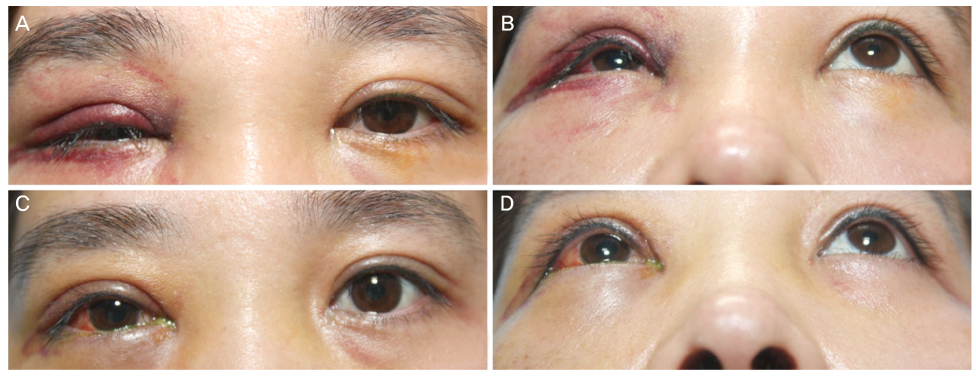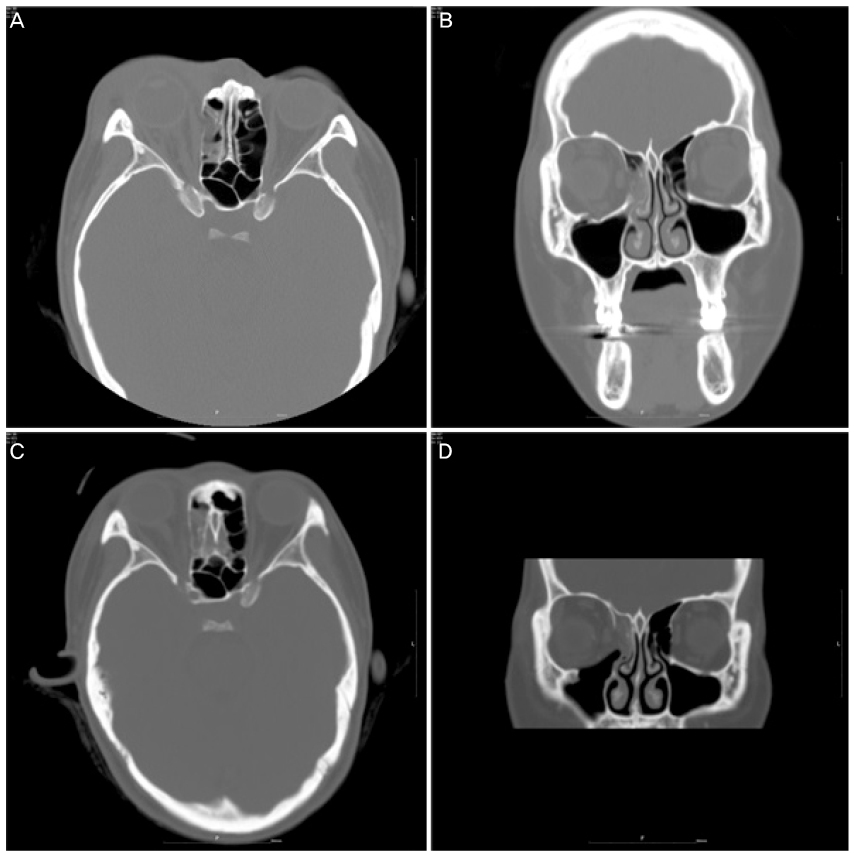J Korean Ophthalmol Soc.
2017 May;58(5):579-585. 10.3341/jkos.2017.58.5.579.
Endoscopic and Transconjunctival versus Transcaruncular and Transconjunctival Reconstruction of Medial and Inferior Orbital Wall Fractures
- Affiliations
-
- 1Department of Ophthalmology, Inha University School of Medicine, Incheon, Korea. Ksm0724@inha.ac.kr
- KMID: 2378629
- DOI: http://doi.org/10.3341/jkos.2017.58.5.579
Abstract
- PURPOSE
To compare two combined surgical techniques, endoscopic endonasal surgery with transconjunctival reconstruction and transcaruncular surgery with transconjunctival reconstruction, when used to treat both medial and inferior orbital wall fractures.
METHODS
A retrospective review of 63 patients who were followed up from January 2011 to December 2014 at Inha University Hospital for surgical reconstruction of combined medial and inferior orbital wall fractures was undertaken. We compared between the patients the computed tomographic scans, diplopia, extraocular muscle (EOM) movements, and Hertel's exophthalmometer exams pre- and post-6 months surgery. A total of 29 patients received endoscopic transnasal surgery with trasconjunctival reconstruction, and 34 received transcaruncular surgery with trans-conjunctival reconstruction.
RESULTS
There were no significant differences between the two combined methods in terms of the primary and peripheral gaze diplopia or the restriction of EOM movement 6 months after surgery. However, statistically significant differences were observed in exophthalmometer measurements 6 months after surgery.
CONCLUSIONS
The two combined surgical methods showed similar results in terms of postoperative primary and peripheral gaze diplopia, EOM restriction, and enophthalmos. With respect to postoperative peripheral diplopia, endoscopic endosnasal surgery with transconjunctival reconstruction showed several advantages over the other method considered in this study. An appropriate surgical method should be selected by comparing the relative advantages and disadvantages.
Figure
Reference
-
1. Ahn SK, Jung SW. The clinical aspects of orbital fractures proven by computed tomography. J Korean Ophthalmol Soc. 1997; 38:2077–2083.2. Lee SY, Kim SY, Kim HB. Orbital fractures evaluated by computed tomography. J Korean Ophthalmol Soc. 1990; 31:249–253.3. Dodick JM, Galin MA, Littleton JT, Sod LM. Concomitant medial wall fracture and blowout fracture of the orbit. Arch Ophthalmol. 1971; 85:273–276.4. Nolasco FP, Mathog RH. Medial orbital wall fractures: classification and clinical profile. Otolaryngol Head Neck Surg. 1995; 112:549–556.5. Warwar RE, Bullock JD, Ballal DR, Ballal RD. Mechanisms of orbital floor fractures: a clinical, experimental, and theoretical study. Ophthal Plast Reconstr Surg. 2000; 16:188–200.6. Rhee JS, Kilde J, Yoganadan N, Pintar F. Orbital blowout fractures: experimental evidence for the pure hydraulic theory. Arch Facial Plast Surg. 2002; 4:98–101.7. Jank S, Schuchter B, Emshoff R, et al. Clinical signs of orbital wall fractures as a function of anatomic location. Oral Surg Oral Med Oral Pathol Oral Radiol Endod. 2003; 96:149–153.8. Burm JS, Chung CH, Oh SJ. Pure orbital wall fracture: new concepts and importance of medial orbital blowout fracture. Plast Reconstr Surg. 1999; 103:1839–1849.9. Suhk JH, Ji SY, Kim TB, Yang WS. Internal fixation of Medpor(R) implant for prevention of enophthalmos in posteriorly extended orbital floor fracture. J Korean Cleft Palate-Craniofac Assoc. 2008; 9:55–61.10. Wilkins RB, Havins WE. Current treatment of blow-out fractures. Ophthalmology. 1982; 89:464–466.11. Lee MS, Lew H, Lee SY. The results of delayed repair for orbital wall fracture. J Korean Ophthalmol Soc. 1998; 39:1049–1054.12. Kroll M, Wolper J. Orbital blowout fractures. Am J Ophthalmol. 1967; 64:1169–1172.13. De Man K, Wijingaarde R, Hes J, de Jong PT. Influence of age on the management of blow-out fractures of the orbital floor. Int J Oral Maxillofac Surg. 1991; 20:330–336.14. Hawes MJ, Dortzbach RK. Surgery on orbital floor fractures. Influence of time of repair and fracture size. Ophthalmology. 1983; 90:1066–1070.15. Dulley B, Fells P. Long-term follow-up of orbital blow-out fracture with and without surgery. Mod Probl Ophthalmol. 1975; 14:467–470.16. Emery JM, Noorden GK, Sclernitzauer DA. Orbital floor fractures: long-term follow-up of cases with and without surgical repair. Trans Am Acad Ophthalmol Otolaryngol. 1971; 75:802–812.17. Mohadjer Y, Hartstein ME. Endoscopic orbital fracture repair. Otolaryngol Clin North Am. 2006; 39:1049–1057. viii18. Rhee JS, Chen CT. Endoscopic approach to medial orbital wall fractures. Facial Plast Surg Clin North Am. 2006; 14:17–23.19. Han K, Choi JH, Choi TH, et al. Comparison of endoscopic endonasal reduction and transcaruncular reduction for the treatment of medial orbital wall fractures. Ann Plast Surg. 2009; 62:258–264.20. Lee CS, Yoon JS, Lee SY. Combined transconjunctival and transcaruncular approach for repair of large medial orbital wall fractures. Arch Ophthalmol. 2009; 127:291–296.
- Full Text Links
- Actions
-
Cited
- CITED
-
- Close
- Share
- Similar articles
-
- Repair of Orbital Wall Fracture Using Transcaruncular Approach
- Usefulness of a Transconjunctival Approach in the Reconstruction of the Medial Blow-Out Wall Fracture
- Transcaruncular Approach to Blowout Fractures of the Medial Orbital Wall
- Treatment of Medial Orbital Wall Fracture Using Medial Transconjunctival Approach
- Reconstruction of Isolated Medial Orbital Wall Fracture Using a Transcaruncular Approach



